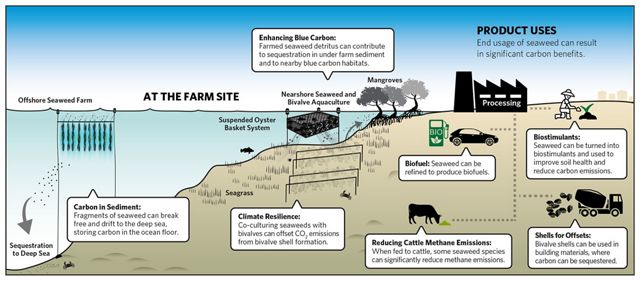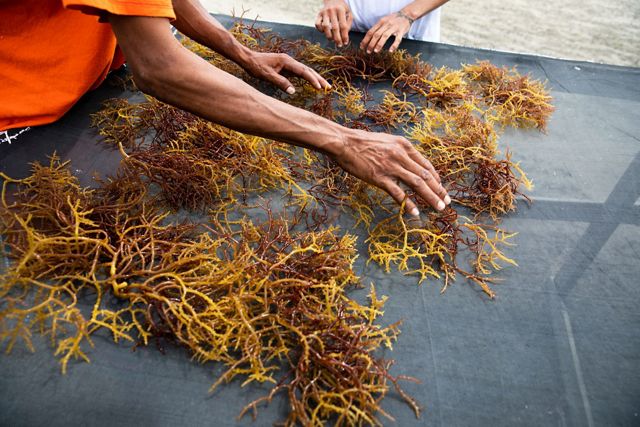With the Right Tools, Seaweed Can Be an Important Piece of the Climate Puzzle
New model could help the seaweed aquaculture industry maximize its climate benefits.

In the fight against the climate crisis, this humble crop has been hyped as a potential solution to both quickly capture carbon and provide a sustainable alternative to carbon-intensive foods and products. But are these benefits borne out by solid scientific evidence? And if they are, how can the industry move forward to maximize seaweed’s environmental potential? The Nature Conservancy’s team of aquaculture scientists and collaborators have been hard at work to answer these questions, in an effort to chart a pragmatic path towards ensuring seaweed can realize its potential as a nature-positive food system.
Blue Carbon Model
Run the Blue Carbon Model of Seaweed ServicesThough the buzz around seaweed is relatively new, its cultivation is certainly not; for centuries, farmed seaweed has played a central role in coastal economies, cultures, and diets, particularly in Asia. Over the last several decades, the industry has grown to become a $16.7 billion market, 80 percent of which is produced in China and Indonesia.
Seaweed aquaculture doesn’t just support livelihoods and food security – its ecosystem services are gaining recognition too. As it grows, seaweed absorbs nitrogen from the water, nitrogen that could otherwise contribute to the growth of algal blooms that gobble up oxygen and create “dead zones” where other aquatic life can’t survive. Seaweed can also bolster biodiversity by providing food and habitat for marine species, and it may be able to offset localized effects of ocean acidification.
But the climate benefits of seaweed aquaculture are a bit more complicated. Seaweed grows up to two feet per day, a remarkable pace that allows it to absorb large amounts of carbon dioxide during photosynthesis. When wild seaweed sinks and is buried in the deep ocean floor, that carbon can theoretically remain there for decades or centuries; however, the sequestration potential of farmed seaweed is highly variable. As an analysis co-authored by Heidi Alleway, TNC’s senior aquaculture scientist, highlights, the majority of farmed seaweed is harvested and consumed by humans in one form or another, removing the majority of the carbon it absorbs from the marine waters.
However, that doesn’t mean that seaweed farming doesn’t sequester any carbon at all. The same study found that some fronds break off and are buried in sediment under the farm, storing carbon in similar ways to wild seaweed. Given this and other studies estimating the sequestration potential of seaweed aquaculture, TNC and Bain recently conducted an analysis of carbon crediting as an economic pathway to grow the global seaweed farming industry and support farmer livelihoods. This analysis determined that carbon markets are unlikely to drive growth at this time as sequestration rates and credit prices are too low to incentivize growth, especially after factoring in additionality and discounts. That said, the amount of carbon sequestered is still be investigated globally and could be influenced by factors such as sediment type under the farm, location, and species.
In addition to providing important environmental outcomes, there are other ways that farmed seaweed can move us closer to net zero emissions. For one, seaweed is one of our lowest impact foods. While global food production accounts for 80% of land degradation, 70% of freshwater use, and 33% of greenhouse gas emissions, seaweed requires no land or freshwater to grow, and emits negligible greenhouse gases in the growing stages.
Seaweed can also help mitigate climate change by replacing carbon-intensive products. A report recently published by TNC and Bain & Company identified bioplastics and biostimulants as two of the most promising markets to drive demand while simultaneously reducing greenhouse gas emissions. Traditional plastics are derived from petroleum and never decompose, instead breaking down into smaller and smaller pieces that pollute our air and waterways, harm wildlife, and infiltrate our food supply. In contrast, bioplastics typically require fewer emissions to produce and are biodegradable. While some bioplastic materials require inputs like land, freshwater, and fertilizer to grow, seaweed doesn’t, making it among the most sustainable bioplastic options.

Similarly, biostimulants (materials that improve terrestrial crop yields and health, nutrient uptake, stress tolerance, and soil quality) derived from seaweed can act as a substitute for less sustainable inputs. In rice field trials, seaweed biostimulants provided the same benefits as chemical fertilizers while generating only about half the carbon emissions per application. There is significant room for growth in this market; by some estimates, only about .5% of global farmland is treated with seaweed biostimulants. Increasing that to 3% of global farmland would boost demand for farmed seaweed to 3 million tons annually and potentially avoid up to 0.75 megatons of carbon emissions per year.
However, there currently isn’t enough demand for seaweed products to support target growth. While both bioplastics and biostimulants could deliver climate and ecosystem benefits, seaweed is often more expensive than traditional products and competing green alternatives. Currently, there is a need to either justify a higher price by differentiating seaweed as a premium product or to lower the price through greater efficiencies, improved processing technology, or subsidies.
To fully realize its environmental benefits, the industry needs to improve the cost position of seaweed without compromising sustainability—growing while stakeholders work together to bridge the remaining gaps in our knowledge, infrastructure, and markets. “Seaweed aquaculture is not a sliver bullet or climate panacea, but it can and should be an important part of a broader climate and biodiversity strategy to reduce carbon emissions in supply chains while providing important ecosystem services to marine environments” says Tiffany Waters, the global lead for TNC’s Restorative Seaweed Initiative.

There are also geographic and species limitations within the seaweed industry. Though there are more than 12,000 species of seaweed, just five account for 95% of all cultivated seaweed. The lack of species diversity makes seaweed aquaculture more vulnerable to shocks like severe weather events and disease, an issue that Alleway wrote about in another paper published last year. Additionally, it limits the potential applications of seaweed, as different species have different characteristics.
A lack of geographic diversity is just as much of a problem, with 98% of farmed seaweed coming from Asia. Expansion on other continents will be necessary to meet environmental goals; however, in many parts of the world, there is a lack of processing and distribution infrastructure, training, and data, which is why TNC is working to develop global resources and tools necessary to advance sustainable seaweed aquaculture.
This month, TNC and Scitech Environmental Consulting released a new global model, the first of its kind, that allows the user to enter seaweed farm and product information to estimate kelp production, associated farm emissions, the potential for in-water marine carbon sequestration and nutrient removal, and the amount of carbon emissions avoided through chosen seaweed replacement products. Aligning with previous reports, the model shows how farming seaweed can help with carbon emissions reductions goals when used as a replacement for more carbon-intensive products, depending on market prices and demand.

This model is global in design and allows the user to select their farm location by marine ecoregions, which are 232 regions that have been characterized for their ecological and oceanographic similarities. For each marine ecoregion, the model includes pre-populated globally available data into relevant parameters. However, the model is adaptable and all parameters can be edited by the user to incorporate unique or localized data. For example, for farmers, NGOs, governments, and/or marine managers who have access to more precise information on ecological factors, the open architecture of the model allows them to edit those variables, which then improves the model accuracy for a specific seaweed farm.
Additionally, given the highly active nature of seaweed research and recognizing that there are important sequestration and LCA product studies currently underway, the model also allows for seaweed product pathways data to be updated. As more information becomes available, it will be possible for updated versions of the model to be developed.
TNC looks forward to continuing to work with our seaweed industry partners and research colleagues in 2024 and beyond to support progress in this innovative and important field.

